The Best Ornamental Trees to Grow in Arizona
Are you looking for trees that thrive in Arizona’s typically hot, dry climate? We’ve got several ornamental species that will spice up your lawn, gardens, and walkways. These picks offer a mix of eye-popping colors, fragrant blossoms, intricate leaves, and decorative fruits. Many of them are even native to the Copper State!
Tipu Tree (Tipuana tipu)
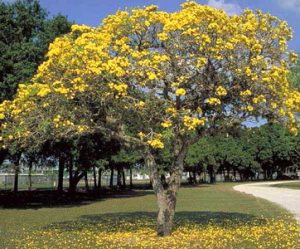
Shade-giving tipu trees are welcome additions to most Arizona landscapes. Tipu trees originate from South America. Since they’re already accustomed to long, hot days and incredibly dry soil, it’s as though they were made for Arizona’s desert climate.
The tipu tree’s expansive canopy serves up a good dose of shade. Its deep yellow flowers put on a splendid show from early spring to fall. The flowers are delicate and pea-shaped. They have a faint smell. If you’re close enough to the flowers, you may pick up on their sweetness. The tree’s pinnately compound leaves grow from short, thin stalks. They’re oval in shape and bright green in color. Individual leaves measure anywhere from 1 to 3 inches in length. They cluster together to create a dense cover that’s relished by insects and small birds.
The leaves tend to shed in early spring. Some landscapers avoid this tree because it can create a sizable mess. Tipu trees can grow to be roughly 100 feet tall and 65 feet wide. They can live to be 150 years old. However, it can take some time to get them up and growing.
Yellow Oleander (Cascabela thevetia)
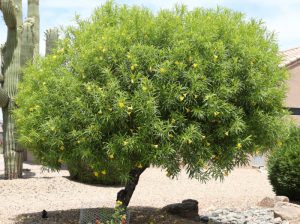
Yellow Oleander is a small evergreen tree that thrives in dry, warm climates like that of Arizona. This shrub-like tree is usually no taller than 8 feet and no wider than 4 feet at maturity. Its green leaves can be anywhere from 3 to 6 inches long. They’re long, narrow, and curled at the edges. Yellow oleander produces an abundance of bright yellow flowers during spring. The blossoms have tube-liked bases and flared tips. The fragrant blooms are typically loaded with pollen. Thus, it comes as no surprise that they are favored by all sorts of native pollinators.
The yellow oleander is native to Mexico and the West Indies. However, it is well-equipped to handle Arizona’s extreme weather.
Texas Olive (Cordia boissieri)

This semi-deciduous tree is an excellent pick for Arizona’s desert climate. Texas olive has an incredible aesthetic. Its dark gray bark, leathery leaves, and white blossoms couldn’t offer up better visual dynamics. The tree’s purple fruits closely resemble olives. With that being said, these sweet berries do not taste like their Mediterranean doppelgangers. In most cases, they’re left for the birds and other small creatures.
The tree is an aggressive flower producer that blooms from late winter to late summer. The horn-shaped flowers’ yellow throats tend to draw in long-beaked hummingbirds. The flowers grow in small clusters at the end of branches. Their proximity to one another makes them easy targets for pollinators.
These lovely trees do not grow to be taller than 15 feet. These multi-trunked trees are often mistaken for shrubs. They can be trimmed so that they have just one dominant trunk.
Texas olive trees can tolerate a variety of conditions. However, they do best in well-draining dirt and sod. They should be watered regularly while they are young. Otherwise, they will become stunted and unproductive.
Strawberry Tree (Arbutus unedo)
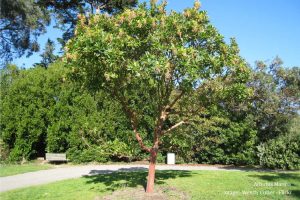
Arbutus unedo, or strawberry tree, is a mesmerizing ornamental that comes to Arizona via Italy. This small evergreen boasts green foliage, reddish-brown bark, white flowers, and pinkish-red berries. It’s similar to a shrub, in that it produces several large trunks. However, it can be trained to grow like a small tree. Its small size and lovely features make it an excellent accent for a landscaping border or hedge.
Strawberry trees bloom from late fall to early winter. The plant’s urn-shaped flowers are white and pink. They are accompanied by glossy green leaves and bright red stems. The flowers fade to make room for the tree’s small drupes. These berry-like fruits are typically ready in spring and early summer. The flavorful drupes are often used in wines and preserves. Fallen fruit is quickly scooped up by native insects, birds, and other wild animals.
It takes strawberry trees roughly five years to produce fruit. Mature strawberry trees grow to heights of 15 to 30 feet. Their canopies can be anywhere from 15 to 30 feet wide. Trees can have one or more trunks.
Jacaranda (Jacaranda mimosifolia)

Jacaranda is a subtropical tree that has had very little trouble adapting to Arizona’s arid landscape. This stunning species produces an abundance of green foliage and purplish-blue flowers. The tree’s trumpet-shaped blossoms typically appear in late spring or early summer. The flowers are typically succeeded by brown seed pods.
Jacaranda trees can grow to be 40 feet tall. Their shade-giving properties and attractive features make them excellent selections for all types of desert landscapes. Keep in mind that these ornamentals do require a good deal of water while they are young and during the hot summer months. They thrive in warm, dry conditions but are sometimes burned by the sun.
Texas Mountain Laurel (Sophora secundiflora)
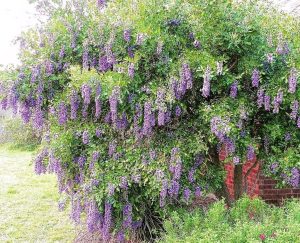
Texas mountain laurel is a multi-trunked evergreen tree that produces an abundance of green foliage and purple flower clusters. This incredible plant does not usually grow to be more than 30 feet tall. Its dense canopy and small size make it an excellent anchor for bords and hedges.
Texas mountain laurel’s violet flowers typically appear in late winter or early spring. The 3- to 7-inch clusters are toxic to mammals. Nevertheless, they’re quite popular with native pollinators.
This is an excellent ornamental for homeowners looking to add color and depth to their yards. It’s easy to propagate and grows relatively fast. No special care is needed during the plant’s formative years.
Feather Tree (Lysiloma microphylla thornberi)
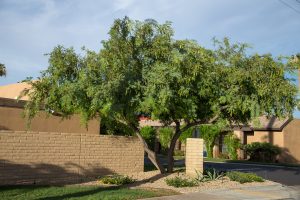
Lysiloma microphylla thornberi, or feather tree, is a desert mainstay that produces a canopy of soft white blooms in late summer. The puffball-like blossoms are small, spikey, and soft. They are accompanied by fern-like pinnacles of leaves.
These trees do not typically grow to be taller or wider than 12 feet at any point. The feather tree, or fern-of-the-desert, is native to the foothills of Arizona’s Rincon Mountains. It’s semi-delicious but remains evergreen in areas that do not experience frost.
Chinese Pistache “Red Push” (Pistacia x ‘Red Push’)
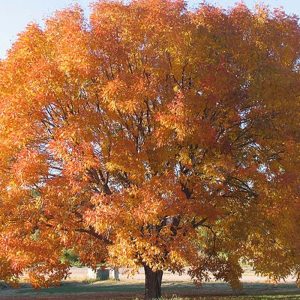
Chinese pistache, or red push, is a desert-hardy plant that produces a specular show of color. This incredible species is a hybrid of the pistachio tree, though it does not produce nuts. It has a singular trunk and a wide, rounded canopy.
The red push’s foliage is favored for its color-changing properties. Its pinnately compound leaves turn a striking shade of deep orange or red in fall. Its foliage, which is dark green for the majority of the year, compiles nicely to make an excellent shaded cover. Its greenish purple flowers precede its leaves.
A mature red push tree can grow to be anywhere from 25 to 40 feet tall and 20 to 40 feet wide. These desert-hardy trees grow incredibly fast, usually at a rate of 13 to 24 inches per year. Mature red push trees make excellent additions to pathways, parking lots, and gardens.
Coral Gum Eucalyptus (Eucalyptus torquata)
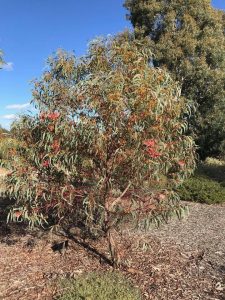
Coral Gum Eucalyptus is another flowering tree that does well in the deserts of Arizona. This Australian-native species has a striking appearance. It produces clusters of pinkish-orange blossoms, cylindrical fruits, and grey-green leaves. The puffball-like blooms stick around for most of spring and summer. They’ll leave your yard smelling like a flower market.
Coral gum eucalyptus trees can grow to be 15 to 25 feet tall. They are drought-resistant and low-maintenance. These awe-inspiring trees are often cultivated for use in small gardens and along streets. It can also be grown in pots on patios and porches.
Hong Kong Orchid Tree (Bauhinia blakeana)
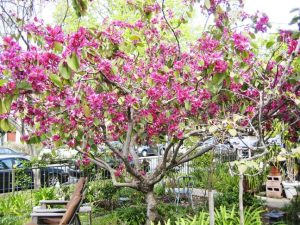
The Hong Kong orchid tree is an ornamental plant that does well in Arizona’s lower desert. This lovely ornamental plant produces an abundance of deep purple flowers and light green leaves. Its lovely blooms last from January to May. These impressive trees can grow to be 30 feet tall at maturity. However, they are often kept small and planted along borders and hedges.
Desert Willow (Chilopsis linearis)
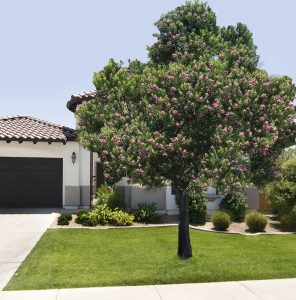
Desert willow is a vibrant desert plant that does well in north-central Arizona. It has a small, twisted trunk that produces an abundance of yellow-like leaves and funnel-shaped flowers. The long, spindly foliage combines to create a dense crown. The flowers, which are purple with yellow centers, are a huge draw for native birds and pollinators.
Kidneywood (Eysenhardtia orthocarpa)
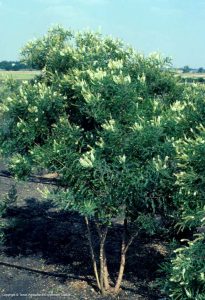
Kidneywood is a small flowering tree that is native to Arizona’s the Sonoran Desert. This small flowering plant boasts multiple trunks. Its dainty green foliage makes a perfect shade cover. Meanwhile, its small white flowers will add a lovely fragrance to your yard in spring.
Kidneywood can grow to be 20 feet tall and 12 feet wide at maturity. It thrives in well-draining soil. It’s an obvious pick for anyone looking for a sustainable or native ornamental for their Arizona yard.
Mastic Tree (Pistacia lentiscus)
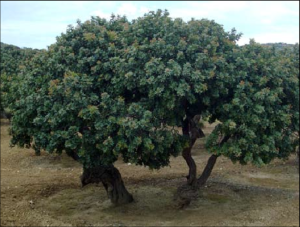
The mastic tree is another evergreen that is native to Arizona. Its leathery green leaves are small and aromatic. Its inconspicuous flowers are hardly noticeable but still appreciated, as they produce ample amounts of pollen. This lovely tree can be anywhere from 15 to 25 feet tall at maturity. Most full-grown mastics have multiple trunks and dense leaf covers. Most mastic tree canopies are between 20 and 30 feet in diameter. These evergreens make excellent shade and border trees. They can even tolerate poor soil and intense heat.
Plumeria (Plumeria rubra)
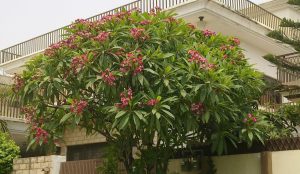
Plumeria (Plumeria rubra) is a small tree that produces an umbrella-like canopy with small leaves and bright flowers. These tropical shrubs typically thrive in the Southwest and can be found in gardens throughout central and northern Arizona.
There are multiple varieties of plumeria on the market. These include ones with white, pink, fuchsia, and orange flowers.
Blue Leaf Wattle (Acacia saligna)
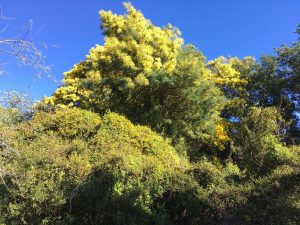
Blue leaf wattle, or blue leaf acacia, is a tall evergreen tree with a rounded canopy and many unique characteristics. During spring, the wattle tree produces large clusters of yellow puffballs. The flowers are fragrant and bright. They fade quickly and give way to small, flat pods.
Screwbean Mesquite (Prosopis pubescens)
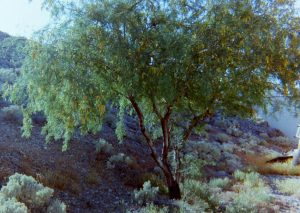
Screwbean mesquite is native to Arizona’s the Sonoran Desert. This tree’s most striking features are its screw-like pods. These incredible beans hang off the tree’s slender branches. The 2-inch growths are green at first. However, they turn brown before falling from the tree’s branches. Pale yellow flowers succeed the vibrant pods. The tree blooms between late winter and early spring. It enters a brief period of dormancy during early winter. These mesmerizing trees do not typically grow to be taller than 30 feet.
Screwbean mesquite is a host plant to the ceraunus blue, the great purple hairstreak, and Reakirt’s blue moths. It’s an excellent pick for an Arizona pollinator garden.
Anacacho Orchid Tree (Bauhinia lunarioides)
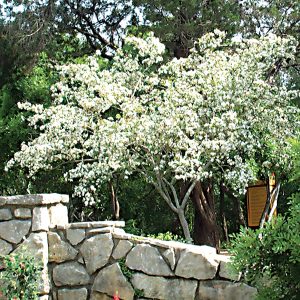
The anacacho orchid tree is a small shrub-like varietal that’s desert-adapted. This impressive plant produces butterfly-shaped leaves and white and pink flower clusters. It’s incredibly small in size, typically growing to be no more than 8 feet tall. It can tolerate temperatures as low as 15 degrees Fahrenheit.
The anacacho orchid tree’s silvery gray bark is yet another detail that adds to its pleasing aesthetic. Its delicate flowers closely resemble actual orchids. Anacacho trees bloom in late winter and early spring. The fragrant flowers do not last long. However, their presence does not go unnoticed by native pollinators and observant gardeners.

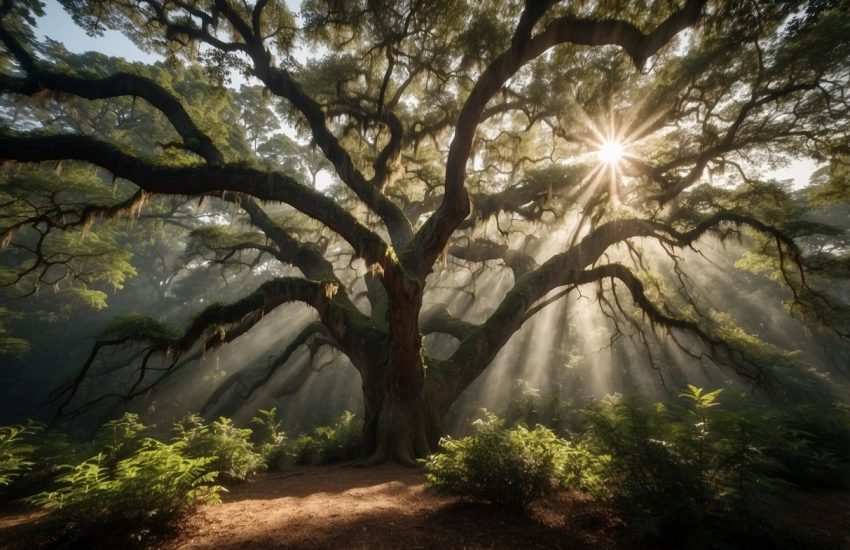
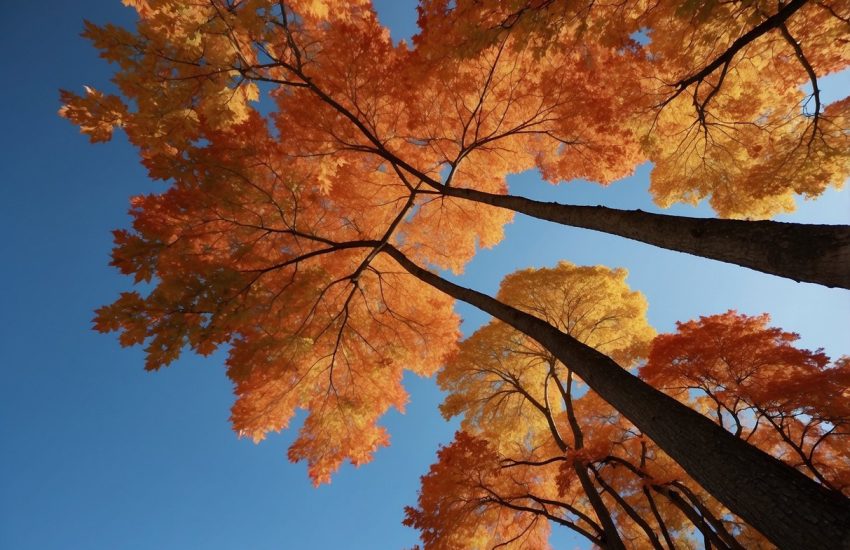
Thank you for this great website! I think there is a mistake about the mastic tree being native to Arizona. Everything else I have right about this tree states that it is native to the Mediterranean.
Thank you!